Honeyeaters

If my memory serves me correctly, Australia has around 60 species of Honeyeater, native Miner and Spinebill. And that’s not even counting the Wattlebirds and Friarbirds. Needless to say, we have struggled with our identification of the many and varied Honeyeaters encountered during our adventures. We have both been heard to comment at times that “these Honeyeaters are doing my head in”.
To make the task more difficult, Honeyeaters are supercharged on a diet consisting mainly of nectar. Like five year olds on too much red cordial, Honeyeaters don’t stay still for very long, making the task of identifying their species, or of taking a half decent photo, all the more challenging.
And if all that wasn’t enough, the difference between many of the species is tiny, to the point where experts have trouble spotting the difference, let alone a couple of mugs like us.
But the effort is certainly worthwhile, as we have learned. Honeyeaters are beautiful, delicate little (and sometimes not so little) birds with long, slender, curved beaks and equally long tongues to aid in their nectar-gathering pursuits. Their plumage consists mainly of yellow, brown, olive, grey and black in every possible combination, though some have a dash of blue here, or purple there. It is the subtle variation in colouring that usually serves to differentiate between the species. Sometimes it may just be a tiny spot of colour behind the beak, or the absence of the same, that separates one species from another.
There is nothing quite like sitting at the foot of a paperbark tree in full bloom and watching the frenetic activity of a flock of Honeyeaters. The noise of their constant chatter, as they dart from flower to flower, can be almost deafening.
Despite their name, Honeyeaters are happy to supplement their diet with insects and fruit.
As with many species of wildlife, the future of the Honeyeaters depends largely on the preservation of suitable habitat. If we continue to clear forests and flowering shrubs at our current rate, there will be fewer of these entertaining birds in the Australian bush. The choice is ours.
tWe hope you enjoy the following photos. I will add more in due course. Early on during our travels I saw the gorgeous Scarlet Honeyeater at Valla Beach NSW, but was without my camera. True to form, I haven’t seen the bird since. It was a salutary lesson for me always to carry a camera!
WHITE-PLUMED HONEYEATER
This is one of the most common Honeyeaters encountered across Australia, but is also one of the prettiest. We have seen so many we almost take them for granted, even though their lovely yellow and olive colouring is always a joy to behold.
We have a regular White-Plumed Honeyeater visitor to our campsite here in Alice Springs. We think he must have taken Spanish lessons because, for all the world, his song sounds exactly like someone is repeating the phrase “Si, don Drago” over and over!

SPINY-CHEEKED HONEYEATER
The Spiny-Cheeked Honeyeater is also fairly common, especially in inland Australia. It is one of the larger Honeyeaters, and has striking facial markings, and a distinctive ‘tok, tok, tok’ call.
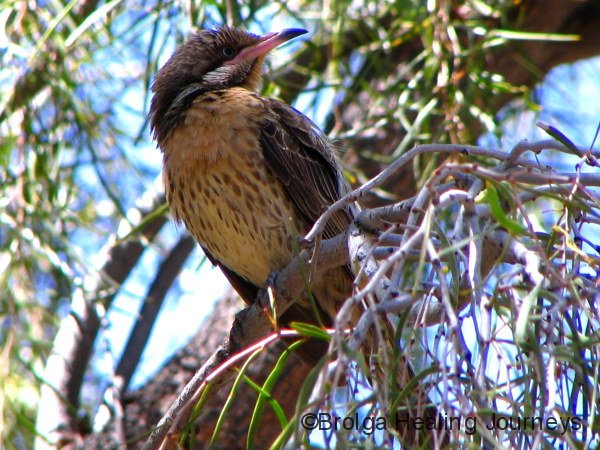
NEW HOLLAND HONEYEATER
We first saw this species, one of the most distinctive of all our Honeyeaters, in the Coffin Bay National Park in South Australia. I spent a frustrating time trying to photograph them there, with only a few blurry shots the result. Fortunately, when we reached the Cape le Grand National Park in Western Australia, I discovered a couple of more sedate subjects.
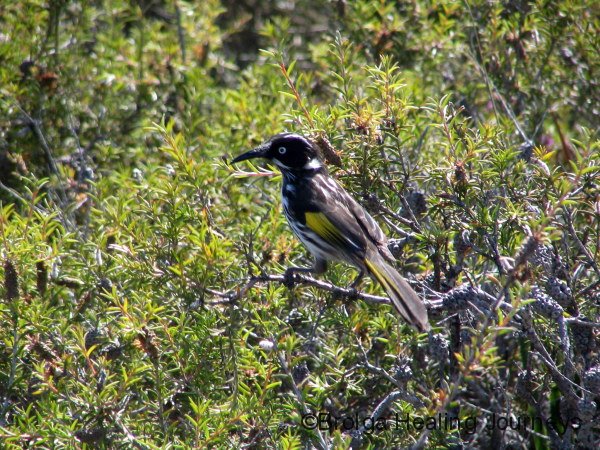
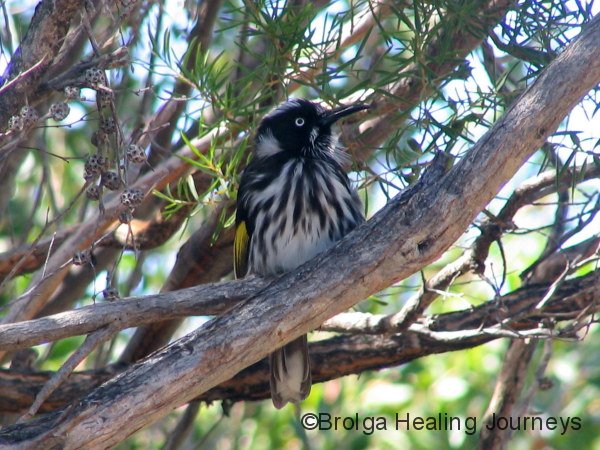
BANDED HONEYEATER & BAR-BREASTED HONEYEATER
We had been out exploring the vast Mornington Wildlife Sanctuary, and were relaxing in the heat of late afternoon beside Cajeput Pool along the Fitzroy River. The restless soul that I am, I went exploring and found a large Cajeput (Paperbark) tree in full bloom. The perfume was almost intoxicating, and the tree was full of birds. I dragged an initially reluctant Nirbeeja to the tree, where we watched spellbound as around fifty Banded and Bar-Breasted Honeyeaters feasted upon the nectar of the blossoms. Nirbeeja was even more reluctant to leave!
It is the only time we have seen either species.
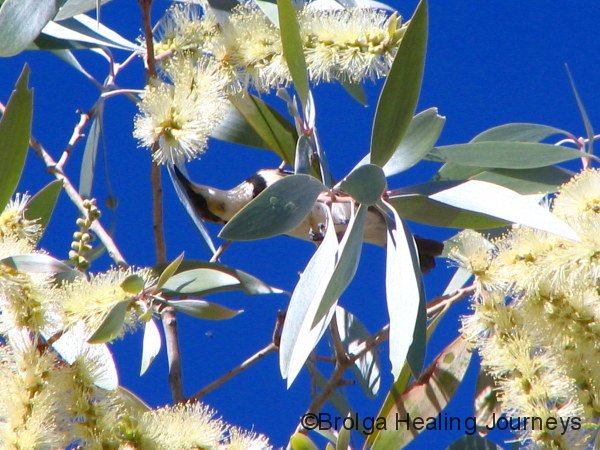
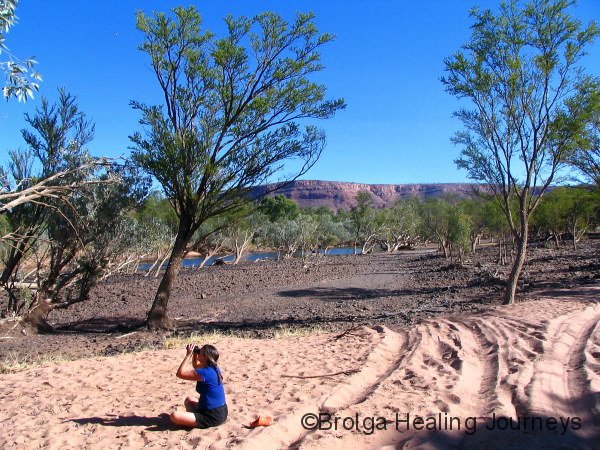
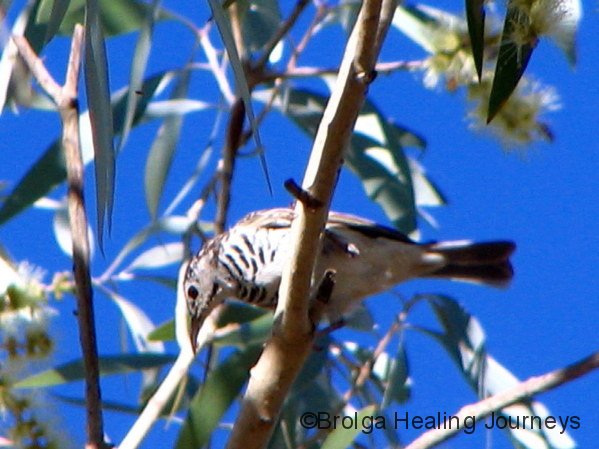
BLUE-FACED HONEYEATER
This large Honeyeater has a stunning, almost sky-blue face. We saw several in southern Queensland and northern NSW, but failed to get a photo. We were quite surprised to see one again a couple of years later, especially all the way over in Mataranka, in the Northern Territory. This isn’t a great photo, but it gives you an idea of what it looks like.
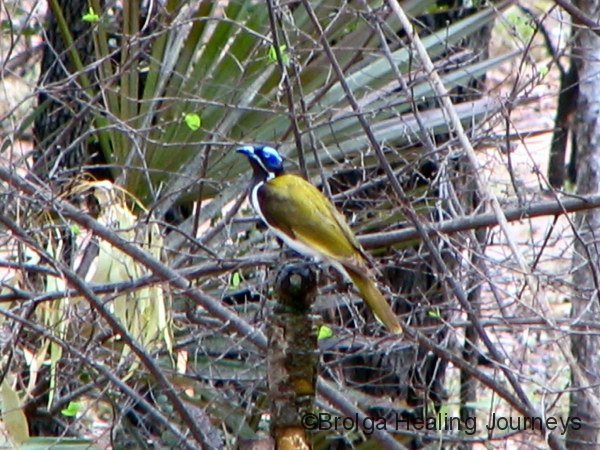
BROWN HONEYEATER
This delightful little bird has a rather boring name. The Brown Honeyeater has a lovely song, and has entertained us in many places during our travels. Interestingly, it has a much nicer song that the Singing Honeyeater which, despite its name, rarely makes much noise at all.

BLACK-CHINNED HONEYEATER & GOLDEN-BACKED HONEYEATER
Don’t let their names mislead you, these are very closely related species. As its name suggests, the Golden-Backed form has a distinctive golden upper back, whereas the Black-Chinned form has more olive colouring. Apart from that they are barely distinguishable.
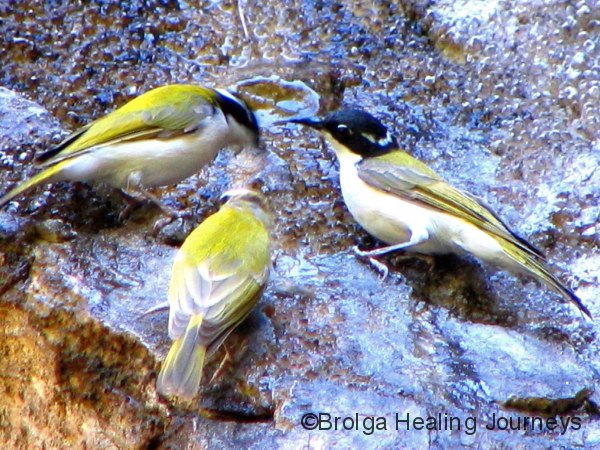
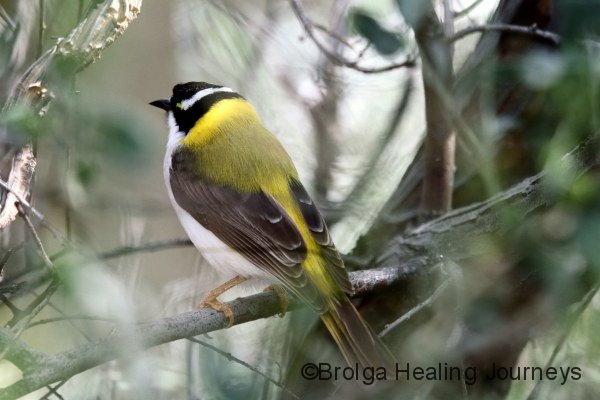
YELLOW-THROATED MINER
Despite its name, the Yellow-Throated Miner is grouped with the Honeyeaters. These spunky, inquisitve birds have been regular visitors to our campsites around central Australia.
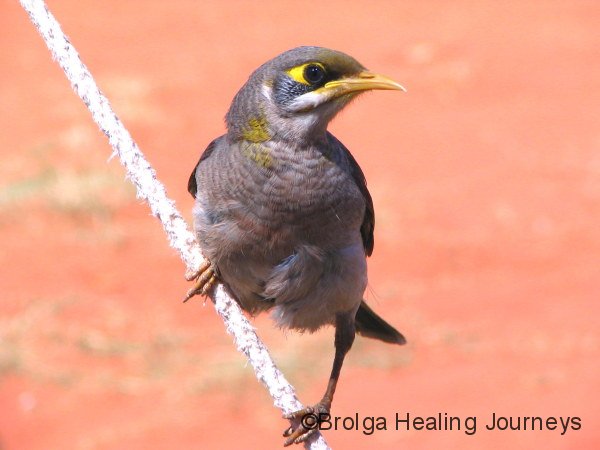
GREY-FRONTED HONEYEATER
I have encountered a number of these Honeyeaters during my walks around the Alice Springs area. Initially, I mistook them for Spiny-Cheeked Honeyeaters, and then for Yellow-Throated Miners. It was only after I had a thorough look at our various bird books that I was able to identify them as the Grey-Fronted Honeyeater.
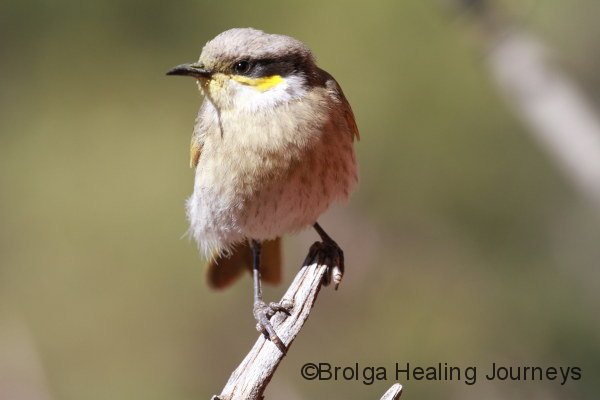
YELLOW-TINTED HONEYEATER
Yes, I know, it looks like many of the other Honeyeaters. Trust me, it’s different. It has a more yellowish colouring than the others and is restricted to the far north of the country - which is where we saw it, twice, in the Kimberley.
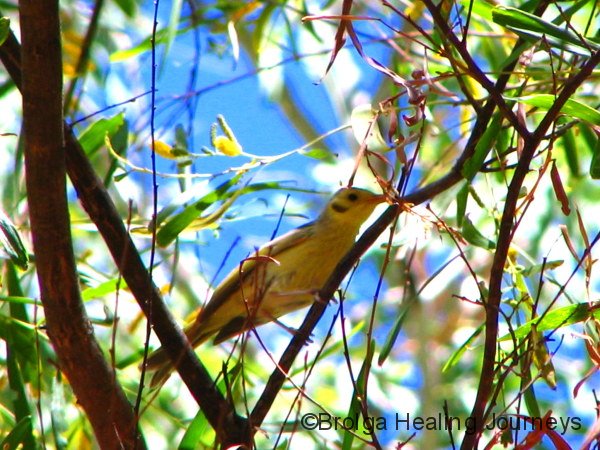
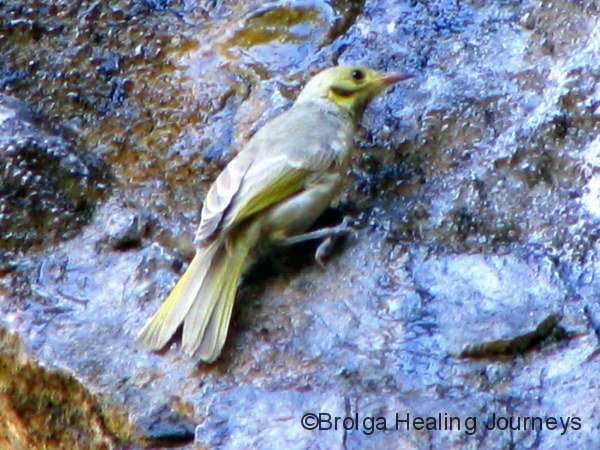
BLACK HONEYEATER
This one lives up to its name. Well, almost. The head, neck, back and wings of the male are solidly black, and a black patch extends down to the chest. The female is much paler, making identification tricky, especially when she is seen away from the male.
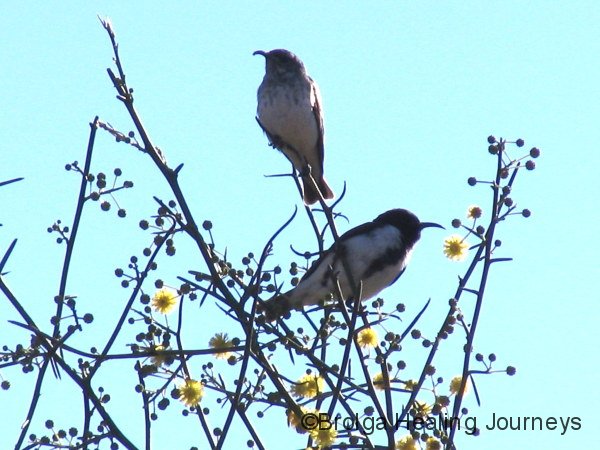
GREY-HEADED HONEYEATER
The Alice Springs Desert Park has a number of these lovely Honeyeaters, which we have otherwise not seen during our travels.
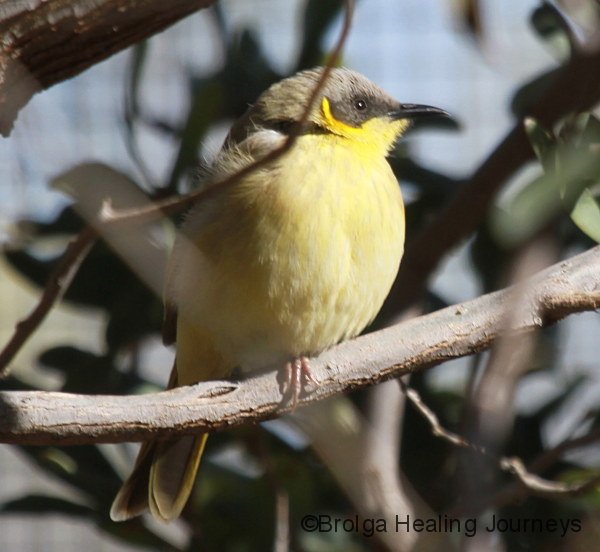
WHITE-GAPED HONEYEATER
The gape is the area immediately behind the corner of the mouth. (No doubt any ornithologists out there will take issue with my description.) Anyway, this mostly grey-coloured Honeyeater has a very distinctive white gape, from which it takes its name. We have only seen one of these, above our campsite at Nitmiluk (Katherine Gorge) National Park.
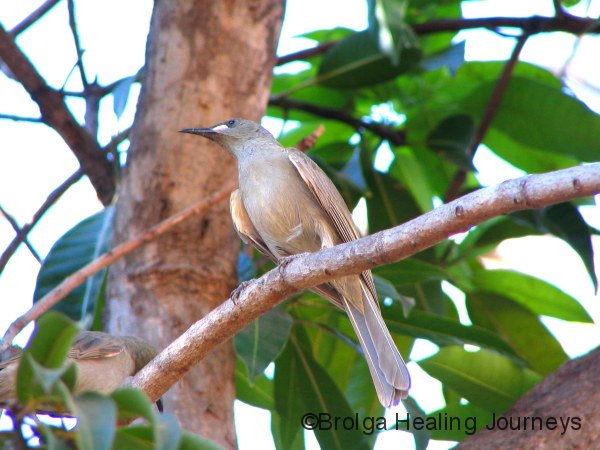
PIED HONEYEATER
This Honeyeater is similar to the Black Honeyeater, but the Pied Honeyeater can be identified by the white patches on its wings.
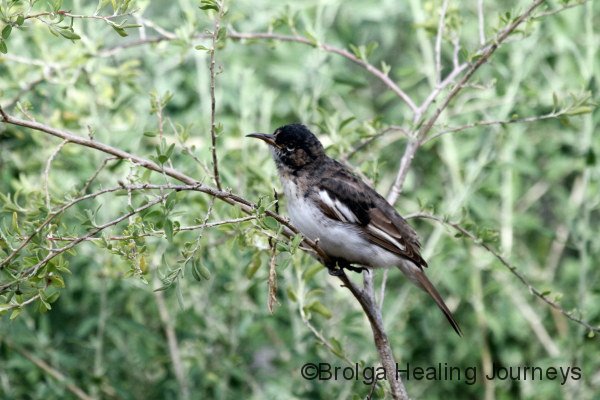
WHITE-FRONTED HONEYEATER
This inland Honeyeater bares some resemblance to the more southerly New Holland species.
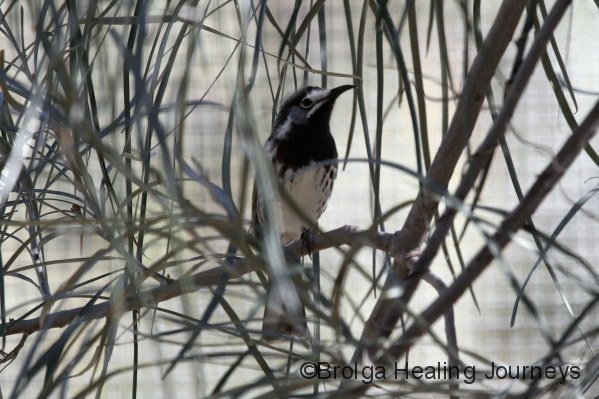
…AND FINALLY, THE “WE’RE NOT SURE – WHAT DO YOU THINK?”, HONEYEATERS
Let us know if you have any ideas!
































































I goole-ed your site to look over some birds from Australia. Our local zoo, the Palm Beach Zoo (here in Florida) is having a contest to guess the name of a new bird they would be placing in their Wallaby Station. I found your site through goole image, and I have to say I have learned alot from your birds. I have never seen such beautiful birds! I have fallen in love with your Warns / Fary Warens and the Splendid Warens. Both Male and Female Warens seem to be a kiss from above.
I have enjoyed your site, I am placing it as one of my favorites in my Wildlife folder. Thank you for sharing – I can’t wait to visit the rest of your categories from your site.
Thank you again,
Nina Salomon
Boynton Beach, Florida USA
Thank you so much Nina for your wonderful comments about our website. We love to be able to share our beautiful wildlife with other people, whether they are here in Australia or in other parts of the world. We hope you enjoy the rest of our site.
Stay in touch!
Peter & Nirbeeja
I got a great picture of a Honey eater (I think) in flight, it was hovering and feeding on a Bottle Brush flower. It was at Coffs Harbour in Queensland.
Not sure which type it is though.